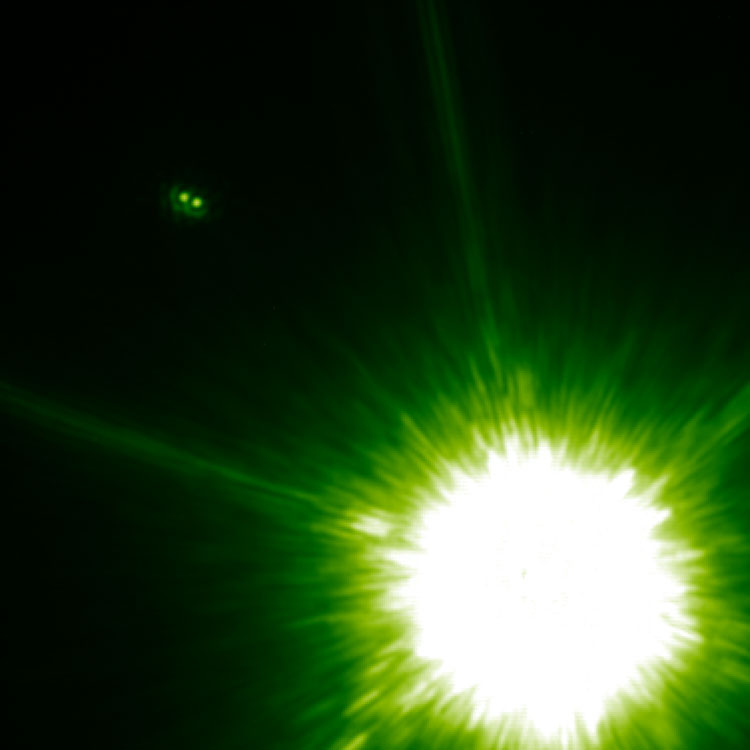Pity the poor brown dwarf; a star wannabe. With as little as 3% the mass of the Sun, brown dwarfs don’t have the gravitational pressure needed to ignite fusion in their cores. Instead of blazing bright, they’re dim little objects that smolder quietly for eons. They’re small and dim, and this makes them almost impossible to locate, let alone weigh. But that’s what a team of astronomers have done. They’ve gathered accurate measurements of the lowest mass, free-floating objects ever seen.
When it comes to being a star, mass is everything. Once a star gets down below a certain point – about 7% the mass of the Sun – it doesn’t have enough pass to ignite nuclear fusion in its core. While our Sun’s temperature is nearly 6000 Kelvin, brown dwarfs are only a little hotter than an oven at 700 Kelvin. A typical brown dwarf will put out 1/300,000th the energy of the Sun. Like I said, cool and hard to find.
The most accurate way of determining mass is by looking for a binary object, where a brown dwarf is orbiting another object, like a higher-mass star (or another brown dwarf). Astronomers from Hawaii and Australia did just that.
Think back to your high school physics class. Johannes Kepler first proved in the 17th century that the total mass of any binary system can be determined by precisely measuring the orbit’s size and how long it takes for the two objects to complete one orbital cycle. If you can accurately measure the orbital periods, the mass is easy to calculate.
It’s measuring the orbital periods that was the trick. Here’s Trent Dupuy from the University of Hawaii’s Institute for Astronomy, “these are very challenging measurements, because brown dwarf binaries have tiny separations on the sky and orbit each other very slowly. We needed to obtain the sharpest measurements that are possible with current telescopes to precisely monitor their motion.”
They gathered their data using the 10-meter Keck II Telescope atop Hawaii’s Mauna Kea. The Keck II is built with an adaptive optics system that’s absolutely perfect this kind of task.
The team measured the mass of two brown dwarf binaries. One was composed of two “methane” brown dwarfs – the coolest kind of brown dwarf. The total mass of the two objects was about 6% of the Sun, so 3% of the Sun each. The other pair was a set of warmer, “dusty” brown dwarfs, with 11% the mass of the Sun – so 5.5% each.
Original Source: IFA News Release


So, would these be ‘light brown’ dwarfs…?
So let me get this straight…judging by this method and the results displayed in the article…whatever % the binary system weighs compared to the mass of the sun, they split it down the middle?
Have they not taken into account the wobble in the orbit, or possibly the central point to consider a binary object?
Based on this logic, we could find a binary system like pluto and charon, say that it has a total combined mass of 15% earth and instantly draw a conclusion of 7.5% each without even needing a measurement other than the orbit…Im highly skeptical
When these Brown Dwarfs are said to be ‘Small’ how small are they – Jupiter sized or something bigger?
They are probably about the size of Jupiter. The more massive ones might actually be smaller, due to gravitational compression, and the lack of outward pressure from the fusion process.
Hard to say sometimes just how large something is. Figuring mass is sometimes a lot easier, and something large doesn’t always have a lot of mass.
There is just something deep down inside me, telling me there is a lot more to brown dwarfs than we know or figure. Especially when there are two in close proximity. I understand the theories, yet something still isn’t right. Hopefully some day soon, we will learn a lot more about these objects.
I think we will learn that there are a lot more brown dwarfs and planemos out there than previously thought.
I’m betting brown dwarfs are as common as M-class stars, maybe even more common.
Another prediction,
The brown dwarfs will be warmer than expected. Just as Jupiter is warmer than expected.
(Gravity or its effect decreases with the passage of time, according to my theortical work. These objects were once stars. and have hotter than expected cores ).